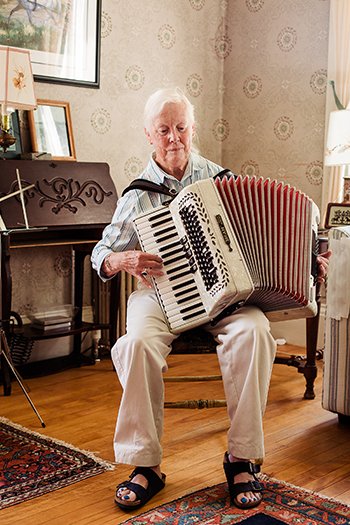Tune Lore, by Sylvia Miskoe
Sylvia Miskoe, founding mother and former music director, remains active in NH Scottish Music Club.
Not everyone is familiar with the tune Over the Waterfall. However, it has an interesting story behind it which I’d like to share.
It turns out that fiddler Alan Jabbour, who worked for the Library of Congress at the time, went on a fiddle tune collecting trip and met up with old time fiddler Henry Reed. Alan recorded a bunch of fiddle tunes from Henry’s playing.
One of them, Over the Waterfall, was especially tuneful and so Alan and his other close music friends learned it and recorded it on a record album. Other fiddlers either learned it from the record album or by ear from people who already played it. I was in the latter group. I learned it at an old time jam in Virginia.
The tune quickly became popular as it spread from fiddler to fiddler and state to state. At that time most fiddlers didn’t know that the tune had been “collected” from Henry Reed by Alan. They just played it because they heard it and liked it.
After I started teaching and writing about fiddling, I was invited to a seminar on old time music and fiddling which was held at Brown University. Alan Jabbour was there. He told me a very interesting story regarding his subsequent visit to Henry Reed. During that visit he told Henry that Over the Waterfall had been recorded onto a record album and had become a popular tune amongst fiddlers.
At that point Henry looked at Alan and said, “I don’t know any tunes by that name.” And Alan said, “But that’s what you told us the name of the tune was.” Henry replied, “I probably just made up a name because I couldn’t remember the real name of the tune.”
So the upshot is that no one actually knows the correct name of the tune commonly called Over the Waterfall.
Over the Waterfall also serves as a good example of the evolution of old time fiddle tunes. Sometime during the middle of the 1990’s, as far as I can determine, some fiddler (mistakenly?) played the last note of the A part as an F#, which differed from Henry Reed’s version, which uses a D note instead. And then, someone transcribed that version into a printed book of tunes. Many people learned it that way.
The tune sounds very different, depending upon which note is played. Admittedly, when two fiddlers play the tune together, one playing the F#, and another playing a D, a cute little harmony is created, since those two notes are both part of a D chord.
D and F# sound good together when two fiddles do that, but F# alone by a single fiddle creates an odd effect because, to my ears, the A part desperately needs to return to its home on the D note. Also, that’s the way Henry Reed played it.
But I can tell you that I heard the F# version dozens of times during a trip to Clifftop. It has really caught on amongst the adult amateur crowd. I don’t hear it played much now amongst the very experienced or pro players. Having learned it in the 1970s, its still a staple of my own repertoire (with the D rather than the F#).
